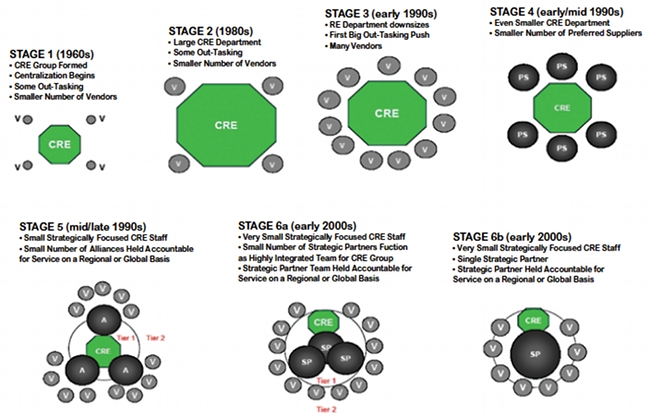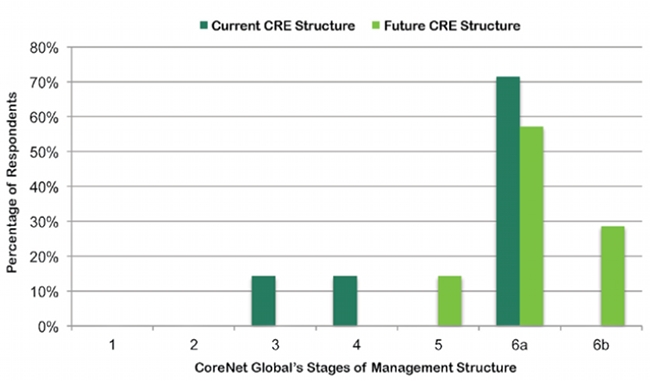by Brent Evans — The pace of globalization has increased exponentially over the last 10 years and continues to do so for organizations, whether they are headquartered in EMEA, Asia Pacific or the Americas. Because of this, there is a greater need for global consistency in operations, which in turn demands better quality communications, strategic planning and efficiencies in how the business is managed “glocally” (globally managed, adapted to local market).
As a result, real estate management structures are becoming increasingly centralized to support businesses on a global scale. This article highlights the benefits of moving to a global approach and examines the critical success factors and likely barriers for such a change. It also observes how real estate management structures are evolving and how this will fundamentally change the way in which corporations manage their real estate in the future.
CBRE undertook a series of interviews with regional and global heads of corporate real estate (CRE) from a selection of global organizations to gauge their views on the globalization of the function. Questions were asked in four key areas:
- The drivers for globalization of CRE management structures
- The barriers to successful implementation of a global CRE structure
- Critical success factors for implementation of a global CRE structure
- Predictions on the future evolution of CRE management structures
Key Drivers for Globalization of CRE Management Structures
- The need for a strategic approach. Having global portfolio oversight offers the ability for executives to identify strategic opportunities across different business units or geographies that ma not be visible to businesses with a local or regionally led structure.
- Driving consistency. While recognizing the need for local differences, improving consistency in communication systems, processes and reporting will provide a greater level of predictable outcomes, decreasing risk and increasing control. As a major investment bank stated, “We must avoid cutting corners and making costly errors.”
- Efficiencies and speed to market. The need for fast decision making and the agility to act quickly is seen as a key driver toward a more integrated model that provides a streamlined structure and process. This was particularly important to financial services respondents as the cost to them for delays or disruption to their business can far outweigh the investment in implementing effective, centralized process, systems and structures.

Source: ©2011, CoreNet Global
Barriers to Successful Implementation of a Global CRE Structure
Adopting a global CRE approach often requires a significant cultural shift for an organization, posing certain challenges.
- Structural silos often exist across geographical boundaries, business units, service lines and even within teams. Getting the right level of engagement and common purpose across these boundaries can be a significant challenge. Interestingly, the concept of silos existing within the company and the supply chain was also raised, with the general perception that a service provider can only be effective in a global or integrated role when its client has the mandate to drive change across these silos.
- Quality of internal resources. While the CRE teams of the respondents varied in size significantly, there was a perceived need for a level of highly skilled “intelligent client” CRE managers to effectively manage suppliers and act as customer relationship managers (CRMs) to the business. Justifying the value of CRE resources can be a challenge. One major investment bank said that its “overhead (of CRE) sits centrally, so costs are always challenged.”
- Senior executive sponsorship. Many of the barriers to globalization identified reflected challenges in obtaining executive/corporate support from the business (both top down and bottom up) in terms of resourcing, mandate and overall acceptance of change. Furthermore, if the CRE organization is misunderstood or undervalued by senior management, this can greatly hinder the ability for CRE teams to secure the mandate they require from the business to drive meaningful change.
How Can We Make This Work?
The top six elements that are critical to success were identified as follows:
- Strategy. CRE strategy must be aligned to business strategy, requiring the engagement of CRE with the business and at all levels.
-

Upskilling. CRE teams must take more of a management approach, focusing on risk management, strategic planning, finance, innovation and business intelligence. Subject matter experts are essential resources for managing the supply chain effectively, with increasing operational and management work being outsourced.
- Partnership. CRE teams must be effectively aligned to their business with executive sponsorship and have leveraged strategic alliances with their supply chain to be successful.
- Process and procedure. This is essential, however, it must not be too complex or cumbersome to administer to add value to productivity.
- Technology. Accurate data and a robust platform on which to manage it are both essential to produce meaningful metrics with which the portfolio can be measured and managed.
-
Global Perspectives
“Speed to market supports our businesses’ revenue generation, while delays can be costly.” — Bank of America Merrill Lynch
“For cRe teams to be effective, they must have a top-down mandate.” — Pfizer
“Skills required of CRE professionals are changing to include more change management experience, strong communications and CRM expertise. Increasingly non-property executives in CRE teams require backgrounds in finance, HR and IT.” — Oracle
“To be effective, we must avoid process for process’ sake.” — Pfizer
“To achieve alignment in terms of business strategy at executive, regional and local levels, it is essential for CRE teams to understand the business of the business.” — Bank of America Merrill Lynch
Performance Management. This allows CRE teams to prove value to the business and demand value from the supply chain. CRE teams’ internal departmental objectives should be used as the basis for key performance indicators with supply chain partners. They include risk/reward structures to ensure effective performance measurement, and compensation of suppliers is aligned to the success of the CRE team. This implies a level of management resource within the CRE team to effectively govern performance target/ review/revise processes.
Where Is the Industry Heading?
- CRE teams will continue to shrink and centralize, requiring increased skills in management, finance, communications and CRM.
- CRE teams will plug into the company at more executive levels and increase its long-range planning, not just react to market conditions.
- More evolved management structures will drive increased outsourcing to supply chain partners, placing greater demands on them to deliver higherquality global or regional services.
- Technology will increasingly enable greater connectivity and collaboration among truly global team structures.
We asked participants to select an organizational structure model that most closely suited their current CRE structure and also indicate their expectation of how this may evolve (Figures 1 and 2). The results quite clearly point toward 6a as the predominant structure, both now and in the future with anticipation that there will be some further movement in the future toward 6b for about 30 percent of respondents.

Source: ©2011, CBRE Ltd.
Global CRE management structures are becoming increasingly centralized across all sectors. The pace of change is accelerating because of increasing demand for agility, efficiency and global consistency. Global management structures are being enabled by advances in technology, mobility and connectivity, changing the way teams communicate and collaborate.
CRE teams are becoming smaller and engaging within their own organizations at a higher level, and the service provider community is becoming more aligned to its client’s business to add value to CRE teams that are becoming more sophisticated and aligned to their own businesses.
There are potential benefits to globalization of the CRE function, however, to implement successfully, there must be executive level sponsorship as well as strategic service partnerships, robust governance structures and effective technology and communications infrastructure. In conclusion, there is a strong argument that, provided the right people, systems, technology and processes are in place, successful globalization of the CRE function is not only possible but inevitable.

Brent Evans is the EMEA Client Solutions Director, Global Corporate Services, for CBRE, U.K.
For more information on this topic, please visit CoreNet Global’s Knowledge
Center Online.
Accelerating Globalisation Through Effective Change Management
http://www2.corenetglobal.org/dotCMS/kcoAsset?assetInode=12070800
Jones Lang LaSalle advance: Better by design: Reshaping the CRE function for
greater impact
http://www2.corenetglobal.org/dotCMS/kcoAsset?assetInode=11330819